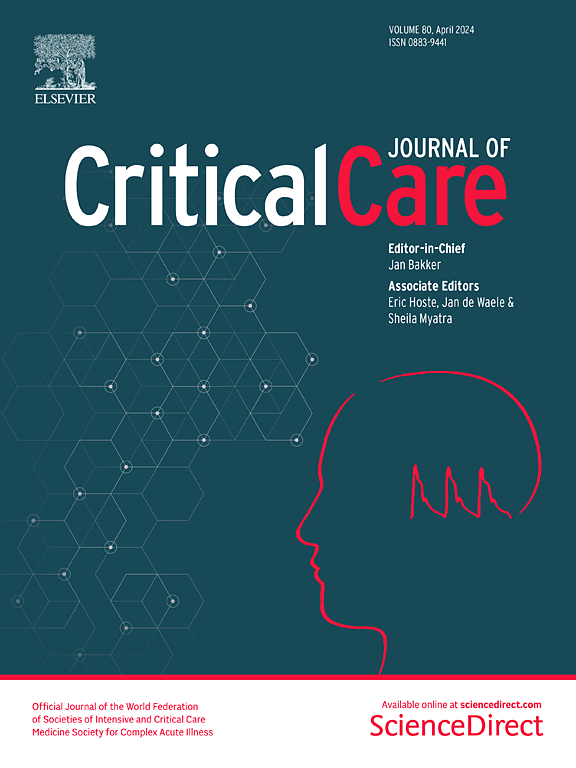Time course of electrical activity of the diaphragm (EAdi) in the peri extubation period and its role as predictor of extubation failure in difficult to wean patients
IF 8.8
1区 医学
Q1 CRITICAL CARE MEDICINE
引用次数: 0
Abstract
Weaning patients from mechanical ventilation is crucial in the management of acute respiratory failure (ARF). Spontaneous breathing trials (SBT) are used to assess readiness for extubation, but extubation failure remains a challenge. Diaphragmatic function, measured by electrical activity of the diaphragm (EAdi), may provide insights into weaning outcomes. This prospective, observational study included difficult-to-wean patients undergoing invasive mechanical ventilation. EAdi was recorded before, during, and after extubation. Patients were categorized into extubation success and failure groups based on reintubation within 48 h. Statistical analysis assessed EAdi patterns and predictive value. Thirty-one patients were analyzed, with six experiencing extubation failure. Overall, EAdi increased significantly between the phases before the SBT, the SBT and post-extubation period, up to 24 h (p < 0.001). EAdi values were higher in the extubation failure group during SBT (p = 0.01). An EAdi > 30 μV during SBT predicted extubation failure with 92% sensitivity and 67% specificity. Multivariable analysis confirmed EAdi as an independent predictor of extubation failure. In difficult-to-wean patients, EAdi increases significantly between the phases before the SBT, the SBT and post-extubation period and is significantly higher in patients experiencing extubation failure. An EAdi > 30 μV during SBT may enhance extubation failure prediction compared to conventional parameters. Advanced monitoring of diaphragmatic function could improve weaning outcomes in critical care settings.难断奶患者在拔管前的膈肌电活动(EAdi)时间过程及其作为拔管失败预测指标的作用
让患者从机械通气中断气是急性呼吸衰竭(ARF)治疗的关键。自主呼吸试验(SBT)用于评估拔管准备情况,但拔管失败仍是一个挑战。通过膈肌电活动(EAdi)测量的膈肌功能可帮助了解断奶结果。这项前瞻性观察研究纳入了接受有创机械通气的难断奶患者。在拔管前、拔管过程中和拔管后记录 EAdi。统计分析评估了 EAdi 的模式和预测价值。对 31 名患者进行了分析,其中 6 名患者出现了拔管失败。总体而言,EAdi 在 SBT 之前、SBT 期间和拔管后的 24 小时内均显著增加(P 30),SBT 期间的 EAdi 预测拔管失败的敏感性为 92%,特异性为 67%。多变量分析证实 EAdi 是预测拔管失败的独立因素。在难断奶患者中,EAdi 在 SBT 前、SBT 和拔管后阶段之间显著增加,在经历拔管失败的患者中明显更高。与传统参数相比,SBT 期间 EAdi > 30 μV 可能会增强对拔管失败的预测。先进的膈肌功能监测可改善重症监护环境中的断奶效果。
本文章由计算机程序翻译,如有差异,请以英文原文为准。
求助全文
约1分钟内获得全文
求助全文
来源期刊

Critical Care
医学-危重病医学
CiteScore
20.60
自引率
3.30%
发文量
348
审稿时长
1.5 months
期刊介绍:
Critical Care is an esteemed international medical journal that undergoes a rigorous peer-review process to maintain its high quality standards. Its primary objective is to enhance the healthcare services offered to critically ill patients. To achieve this, the journal focuses on gathering, exchanging, disseminating, and endorsing evidence-based information that is highly relevant to intensivists. By doing so, Critical Care seeks to provide a thorough and inclusive examination of the intensive care field.
 求助内容:
求助内容: 应助结果提醒方式:
应助结果提醒方式:


